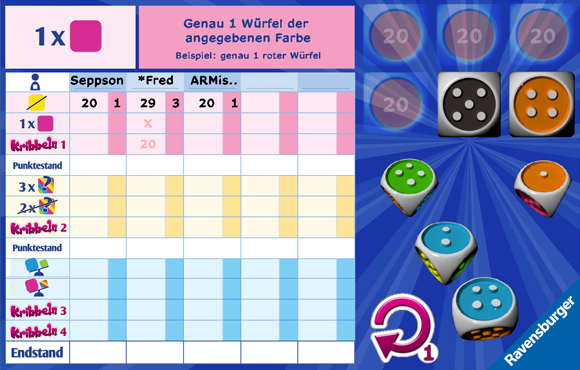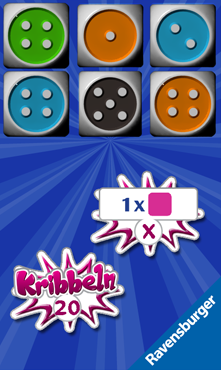Kribbeln
Kribbeln (Originalregel)
Game idea
Whoever is in the series has three attempts to fulfill a task and to achieve as high a cube as possible.
Only those who dice high can make many points – but those who do not manage the task will be empty unless he can take advantage of his second chance.
Online operation

On the left you see the block where the points and the game stand are listed. On the right hand side, the control area in which you select your cubes is newly diceed and laid out. You also finish the train here by your corresponding entry in the block.
Control panel
In the three pictures you can see the sequence of a train and the respective operating possibilities. After dice, you can place your cubes "out" (top) and move them into the cube area (bottom). A double click on a cube automatically puts it "rough"; a double click on the upper delivery area immediately "roughs" all cubes.



By means of the new cube arrow at the bottom left you can dice all uncovered cubes again. If you have put all the cubes out, you can enter your value either into the tingling field or the task field (last image).
Date
You play first all reihum the first line of the score sheet, then the second etc. Once all have made an entry in one line, the score points are distributed directly.
During one train you have three dice tests to perform the current task.
At the same time, attempts to achieve the highest possible cube sum.
So you can cube up to 3 times and decide each time again whether you put cubes away, take the cubes back to the cube or no longer want to cube.
Tasks
To perform the tasks, you have to dice certain colors. The tasks are easy to understand by their symbols and the following explanation.
Task fulfilled?
Whether a task is fulfilled and how many points it brings you, you see on the cube tray. If you cannot fulfill the task after 3 attempts, you can decide:
- Either enter an X into the task field and thus give up points
- or enter the cube sum into the cube field of the same background color. Then immediately try the current task again. You have 3 dice again
Once a line is completely filled, so each player has its cube sum or an X in its field, the points are determined for each player. The points depend on the number of players: The player with the highest cube sum receives as many points as players participate. The second place gets a point less etc. Whoever entered an X does not receive points.
If several players have scored the same cube in one row, they will get all the points of the correspondingly lower place. The next line starts the player who has the highest value in the line above.
Cribble fields
The color of the dice doesn't matter here. The Kniff: Your cube sum entered in the Kribbel fields must always grow from top to bottom. If it is, you can enter your cube sum. If you don't, a X will be entered in the field. In the tingling field, the entry must therefore always be larger than in all its own tingling fields before. In the first tingling field, therefore, each sum is possible.
Here, too, the line is evaluated if all players have an entry. The score points are distributed as described above.
Playing
Once all rows of the score sheet have been filled and evaluated, the game ends. All points are added and thus end up. The player with the highest overall result won! In case of a match, those players have won the one who has the higher result in the tingling field 4. There are several winners.

